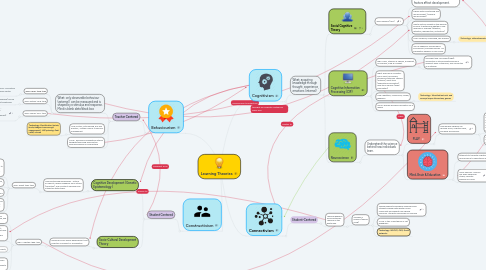
1. Behaviourism
1.1. Teacher Centered
1.1.1. What: only observable behaviour (external) can be measured and is shaped by a stimulus and response. Mind is blank slate/black box
1.1.1.1. Who: Pavlov 1849-1936
1.1.1.1.1. Classical conditioning - involuntary response to previously neutral stimulus
1.1.1.2. Who: Watson 1878-1958
1.1.1.2.1. Behaviour (response) can be programmed/conditioned
1.1.1.3. Who: Skinner 1904-1990
1.1.1.3.1. Operant conditioning - voluntary response to conseuqence (punishment/reinforcement) see video Link
1.1.2. How: lecture, rote learning, drill and practice, multiple choice. Classroom management.
1.1.2.1. Technology: Gamification (points, levels, badges to encourage engagement). LMS quizzing, flash cards, e-book
1.1.3. ISSUE: Excludes consideration internal thoughts/reasoning and emotion. Assumes behaviour is predictable
2. Constructivism
2.1. Student Centered
2.1.1. Cognitive Development (Genetic Epistemology )
2.1.1.1. Learning through experiences - actions on objects, receive feedback from actions (reflection), and construct meaning from interaction with others.
2.1.1.1.1. Who: Piaget 1896-1980
2.1.2. Socio-Cultural Development Theory
2.1.2.1. Learning occurs before development. and cognition is product of socialization
2.1.2.1.1. Who: Vygotsky 1896-1934
3. Cognitivism
3.1. What: acquiring knowledge through thought, experience, emotions (internal)
3.1.1. Social Cognitive Theory
3.1.1.1. Who: Bandura (1977)
3.1.1.1.1. What: learning in social context by observing others. Personal, environmental and behavioural factors affect development.
3.1.1.1.2. Agrees with conditioning and reinforcement (vicarious reinforcement)
3.1.1.1.3. mental factors mediate in the learning process to determine whether a new response is acquired (attention, retention, reproduction, motivation)
3.1.1.1.4. How: Modeling, scaffolding, self-efficacy
3.1.1.1.5. ISSUE: behaviour influenced by environment, excludes biology. No explanation absence of role model
3.1.2. Cognitive Information Processing (CIP)
3.1.2.1. Who: Miller, Atkinson & Shiffrin, Rumelhart, McClelland, Craik & Lockhart
3.1.2.1.1. Rumelhart and McClelland(1988)- information is stored simultaneously in different areas of the brain, and connected as a network.
3.1.2.2. What: brain like a computer. Info is input, processed, stored and retrieved. Sensory (retrieval), short-term (understand information) , long-term memory (apply information)
3.1.2.3. How: repetition, mnemonics, review, feedback
3.1.2.3.1. Technology: Visualization tools and concept maps. discussions, games
3.1.2.4. ISSUE: learners process information for a reason
3.1.3. Neuroscience
3.1.3.1. Understand the science behind how individuals learn.
3.1.3.1.1. PLAY
3.1.3.1.2. Mind, Brain & Education
4. Connectivism
4.1. Student-Centered
4.1.1. Learning happens across networks. Learning in the digital age.
4.1.1.1. Siemens & Downes (approx 2008)
4.1.1.1.1. Teacher supports individuals learning online. Students engage with greater online community and benefit from shared resources. Students responsible for learning
4.1.1.1.2. ISSUE: is this a new theory or just pedagogy?
4.1.1.1.3. Technology: MOOCS, OER, Social networks
